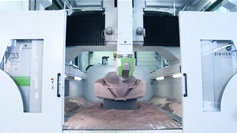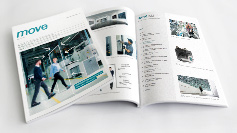WITTENSTEIN presents new miniaturized Galaxie® gearbox
WITTENSTEIN’s miniaturized Galaxie® gearbox is a newly developed, high precision gearbox with axial power transmission. Compared to strain wave gearboxes with the same footprint, it convinces with much better torsional rigidity, significantly higher torque density, double the emergency stop torque and an almost 50% larger hollow shaft diameter, depending on the size.
The miniaturized Galaxie® also offers true zero backlash throughout its entire lifetime. These characteristics are ideal for applications in medical and precision robotics, semiconductor and wafer handling systems or high-end machine tools.
Dynamic single teeth as well as tooth contact over a large surface rather than simply linear contact when the teeth are in mesh are just two of numerous features which the miniaturized Galaxie® has inherited as “genetic code” from its multi-award-winning “big brother / sister”, which first appeared on the scene in 2015.
Smaller sizes due to kinematics with axial power transmission
Power transmission in the new gearbox is axial, not radial – a most ingenious idea. The single teeth in the tooth carrier, which are arranged in a gear ring, are axially driven by a polygonal disc with two high points into the flat wheel with special helical crown gearing, similar to a screwing movement. This axial kinematic is responsible for the compact outer dimensions of the new Galaxie® in the standard sizes typically encountered in robotics applications.
Axial function principle enables high rigidity in small sizes along with a high ratio
The teeth of the miniaturized Galaxie® gearbox are fundamental to the axial function principle. They are designed as so-called “crown” teeth, in other words they have more flanks per tooth and thus more flank surface, enabling almost complete surface contact when in mesh – in contrast to strain wave gearboxes with linear contact. In addition, the movement of the polygonal disc in the new Galaxie® means the majority of the crown teeth constantly contribute to torque transmission and torsional rigidity. The bottom line is three times better rigidity compared to strain wave gearboxes. The crown tooth concept also has another advantage: it allows the new Galaxie® to achieve ratios of i=60/61 and in the future even higher – which is a key performance requirement in robotics applications.
Large hollow shaft: ample space for cables, leads and penetrations
The axial kinematics of the miniaturized Galaxie® pave the way for more compact sizes – creating extra space inside the gearbox. The outcome is an almost 50 percent larger hollow shaft diameter, for example 31 millimeters in size 90 – a full ten millimeters more than strain wave gearboxes with the same footprint. Even more cables, tubes or other connections can be laid inside robots as a result. Larger bending radii are likewise possible – with significantly less risk of cable breakage.
From 90 Nm to over 7500 Nm from a single source
Regardless of whether the kinematic principle is radial or axial, the entire Galaxie® class meanwhile ships in sizes from 90 mm to 300 mm outer diameter with maximum acceleration torques from 150 Nm to over 7500 Nm – a range unmatched by any other single-source manufacturer in this form.
Pictures: (sources for photos: WITTENSTEIN SE)
Photo 1: The crown tooth concept allows the new Galaxie® to achieve ratios of i=60/61 and in the future even higher. This is a key performance requirement in robotics.
Photo 2: The miniaturized Galaxie® convinces as a high precision gearbox with axial power transmission.



